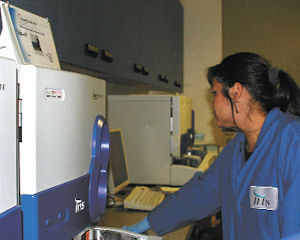IRIS International Inc. is increasing production of its new automated urinalysis systems in hopes of reaching new clients at small laboratories. The Chatsworth-based maker of in-vitro diagnostics systems and components launched its iRICELL 1500 urine testing system — designed to serve labs that perform fewer than 70 urine tests per day — to U.S. consumers late last month, said Tom Warekois, president of the company’s diagnostics division. “We can now essentially serve 90 percent of the market with our product,” Warekois said, noting that the new market segment includes about 2,000 laboratories. “We’re expecting this, over time, will add about another 15 to 20 percent of units to our global demand.” Warekois said the new system addresses a growing industry demand for automated urinalysis systems that are priced more affordably than other higher-capacity products on the market. He attributed the increasing demand to lab technician shortages. “They’re having fewer and fewer skilled technicians entering the business, but the volume of lab testing is increasing because the older population needs more testing,” Warekois said. The company’s iRICELL automated urinalysis systems provide urine testing and analysis in place of the technician, who can then turn his or her attention to other processes that are not automated, Warekois said. Scott Gleason, research analyst for financial services firm Stephens Inc., said entering into the U.S.’s smaller lab market is a smart move by the company. “They’ve (already) penetrated a higher percentage of the higher end of the market — this allows them to grow into new areas,” Gleason said, who specializes in medical diagnostics and lab services equipment. Other medical device companies have used the same tactic and have been successful, he said. Warkois said the new product costs about 15 percent less than the company’s earlier iRICELL models, which sell in the United States for about $100,000 a unit. That places the cost of the iRICELL 1500 at around $85,000. IRIS was already selling the product in Germany. The company has been selling the “2000” and “3000” versions of the system to mid- and large-size labs worldwide worldwide for years, but it didn’t start selling them domestically until March, Warekois said. Gleason said the impact to the company’s revenues and profit margin likely won’t occur right away. “You have to go out and start addressing the customer base,” he said. “It will ramp up over time.” Ernest Andberg, securities analyst for securities brokerage and investing banking firm Feltl and Company, said he is expecting a modest impact to revenues from the iRICELL 1500, since the company has already been selling some components of the system. However, one strength of the product line is that IRIS uses its own chemistry analyzer product, which was recently approved by the FDA, he said. IRIS previously used a product produced by a third-party overseas manufacturer. This will help the company grow its profit margin because customers using the iRICELL systems also will have to order IRIS’s chemistry analyzer supplies, Andberg said. So far, IRIS has sold the iRICELL 1500 to one U.S. hospital group, Warekois said. The company’s sales employees are reaching out to potential clients to make more deals, he added. Including all of its products, the company has about 3,200 units installed worldwide, with about 1,300 of those installed in the United States, Warekois said. The iRICELL systems contributed to higher sales for IRIS for the second quarter of this year. The company’s total revenue increased year-over year by 13 percent with $30.2 million generated for the second quarter of 2011, compared to $26.7 million for the same period last year, IRIS said, earlier this month. That increase was attributed to higher instrument sales in the company’s diagnostics business, particularly driven by demand for the iRICELL systems. IRIS had a net loss of $300,000 for the most recent quarter, compared to net income of $600,000 a year ago, reflecting losses from another company segment.
